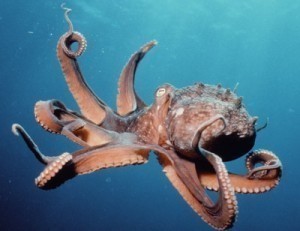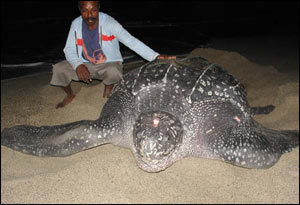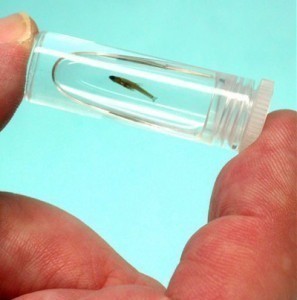Size of an Octopus
They are among the most formidable predators in the sea, considered by many as  the most intelligent aquatic invertebrates of them all. There are approximately 300 recognized species of octopus, 100 of which belong to its largest genus, also named Octopus.
the most intelligent aquatic invertebrates of them all. There are approximately 300 recognized species of octopus, 100 of which belong to its largest genus, also named Octopus.
Among these is the California Two-Spot Octopus (Octopus bimaculoides), obviously named for the Californian coast it calls home, as well as for the 2 blue circular spots situated on opposite sides of its head, just below each eye. Also called the Bimac Octopus, this domesticated species has a mantle length (ML) of 17.5 cm (7 in) with an arm span of 58 cm (23 in).
The Caribbean Reef Octopus (Octopus briareus) thrives in warm waters and dwells among coral reefs. With the chameleon-like ability to blend in with its environment by changing its texture and color, it has a weight of about 1.5 kg (3.3 lbs). Also capable of changing its color is the misleadingly-named Big Blue Octopus (Octopus cyanea), endemic to both the Indian and Pacific Ocean. Also called Cyane’s Octopus and the Day Octopus, it can reach a mantle length of 16 cm and an arm length of no less than 80 cm.
With a 4.5 cm (1.8 in) ML and arms up to a length of 9 cm (3.5 in), the Atlantic Pygmy Octopus or Small-egg Caribbean Pygmy (Octopus joubini) takes advantage of its small size to hide from predators by squeezing into any form of shelter they can find, be it clam shells, empty beer cans or any cracks they can slip into. The Southern Sand Octopus (Octopus kaurna) evades detection by burying itself in the sand all day, only surfacing at night to forage for food. Found along Tasmania and the Great Australian Bight, it arms up to 50 cm (20 in).
Indegenous to the Mediterranean Sea, the Atlantic White-spotted Octopus (Octopus macropus) has a mantle length of 15 cm and an arm span of over 1 m. Occurring in the waters of South Africa, the Southern Giant Octopus (Octopus magnificus) can achieve a maximum length of 1.8 m and a weight of 11.4 kg. From the west coast of North America, the East Pacific Red Octopus (Octopus rubescens) is named for its color, but is capable of changing its hue from red to brown, white or a splotched combination of the three. It has an 8-10 cm ML, arms to 30-40 cm, and an average adult mass of 100-150 g, although some 400 g specimens have been detected.
The medium-sized Coconut Octopus (Octopus marginatus) is a tropical species hailing from the western part of the Pacific Ocean, and is so named because of its use of coconut shells (as well as seashells) for shelter. It generally measures about 8 cm (3 in) and has an arm span of around 15 cm (6 in). The Common Octopus (Octopus vulgaris) camouflages itself by changing its color, then strikes at its prey by paralyzing it with nerve toxin. Considered the most studied species of octopus, it reaches a mantle length of 25 cm and an arm length of up to 1 m.
The popular image of the Octopus is that of a fierce Kraken-like behemoth with crushing tentacles. But as it turns out, these creatures come in a variety of sizes and rely on much more than just their brawn. They’re not quite the lumbering beasts most people take them for, but are actually a very stealthy breed of marine animals. With their ability to blend into their surroundings and attack when least expected, they may as well be considered the ninja of the sea.





